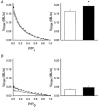Effects of thyroxine on myosin isoform expression and mechanical properties in guinea-pig smooth muscle
- PMID: 12231636
- PMCID: PMC2290541
- DOI: 10.1113/jphysiol.2002.025494
Effects of thyroxine on myosin isoform expression and mechanical properties in guinea-pig smooth muscle
Erratum in
-
Correction to 'Effects of thyroxine on myosin isoform expression and mechanical properties in guinea-pig smooth muscle'.J Physiol. 2024 Jun;602(12):2999. doi: 10.1113/JP286921. Epub 2024 Jun 3. J Physiol. 2024. PMID: 38829242 No abstract available.
Abstract
Information on the effects of thyroid hormone on smooth muscle contractile protein expression and mechanical properties is sparse. We have addressed the following questions. (1) Can thyroxine hormone alter myosin isoform composition in smooth muscle? (2) Can a change in myosin isoform composition lead to altered mechanical properties in smooth muscle? (3) Are alterations, if occurring, equal in fast and slow smooth muscle types? Guinea-pigs were treated with thyroxine (T(4)) for 12 days. Control animals were given physiological saline solution. Maximal unloaded shortening velocity (V(max)) was measured in chemically skinned, maximally activated muscle preparations from the aorta and the taenia coli. V(max) increased following thyroxine treatment, by approximately 20 % in the taenia coli. In the aorta, no significant increase in V(max) could be detected. The sensitivity of isometric force to inorganic phosphate (P(i)) was increased in the taenia coli following thyroxine treatment. The expression of mRNA (determined with RT-PCR) for the myosin heavy chain with the seven amino acid insert increased by approximately 70 % in the aorta and about 25 % in the taenia coli following thyroxine treatment. Western blot analysis showed an increase in the inserted myosin heavy chain form in the taenia coli. Expression of mRNA for the myosin essential light chains and the corresponding proteins did not change significantly in either muscle type. No alterations in non-muscle myosin heavy chain isoforms could be detected after thyroxine treatment. In conclusion, thyroxine treatment alters the isoform composition of myosin in fast and slow smooth muscles in vivo. This change is sufficient to increase shortening velocity and sensitivity of isometric force to P(i) in the fast, but not in the slow, smooth muscle type.
Figures




Similar articles
-
Decreased shortening velocity and altered myosin isoforms in guinea-pig hypertrophic intestinal smooth muscle.J Physiol. 2002 Nov 1;544(3):707-14. doi: 10.1113/jphysiol.2002.027060. J Physiol. 2002. PMID: 12411517 Free PMC article.
-
Substrate and product dependence of force and shortening in fast and slow smooth muscle.J Gen Physiol. 2001 May;117(5):407-18. doi: 10.1085/jgp.117.5.407. J Gen Physiol. 2001. PMID: 11331350 Free PMC article.
-
Smooth muscle myosin isoform expression and LC20 phosphorylation in innate rat airway hyperresponsiveness.Am J Physiol Lung Cell Mol Physiol. 2006 Nov;291(5):L932-40. doi: 10.1152/ajplung.00339.2004. Epub 2006 Jun 9. Am J Physiol Lung Cell Mol Physiol. 2006. PMID: 16766577
-
Myosin light chain phosphorylation at resting level and the composition of myosin isoforms in the bladder body and urethra.Scand J Urol Nephrol Suppl. 1999;201:46-50. doi: 10.1080/003655999750042141. Scand J Urol Nephrol Suppl. 1999. PMID: 10573776 Review.
-
C-terminal isoforms of the myosin heavy chain and smooth muscle function.Comp Biochem Physiol B Biochem Mol Biol. 1997 May;117(1):3-11. doi: 10.1016/s0305-0491(96)00308-2. Comp Biochem Physiol B Biochem Mol Biol. 1997. PMID: 9180009 Review.
Cited by
-
Decreased shortening velocity and altered myosin isoforms in guinea-pig hypertrophic intestinal smooth muscle.J Physiol. 2002 Nov 1;544(3):707-14. doi: 10.1113/jphysiol.2002.027060. J Physiol. 2002. PMID: 12411517 Free PMC article.
-
Vascular smooth muscle phenotypic diversity and function.Physiol Genomics. 2010 Nov 15;42A(3):169-87. doi: 10.1152/physiolgenomics.00111.2010. Epub 2010 Aug 24. Physiol Genomics. 2010. PMID: 20736412 Free PMC article. Review.
-
Smooth, slow and smart muscle motors.J Muscle Res Cell Motil. 2003;24(2-3):165-73. doi: 10.1023/a:1026001513928. J Muscle Res Cell Motil. 2003. PMID: 14609028 Review.
-
Esophagus motility in overt hypothyroidism.J Endocrinol Invest. 2014 Jul;37(7):639-44. doi: 10.1007/s40618-014-0085-6. Epub 2014 May 21. J Endocrinol Invest. 2014. PMID: 24844564
-
Ontogenetic profile of the expression of thyroid hormone receptors in rat and human corpora cavernosa of the penis.J Sex Med. 2010 Apr;7(4 Pt 1):1381-90. doi: 10.1111/j.1743-6109.2009.01701.x. Epub 2010 Feb 5. J Sex Med. 2010. PMID: 20141582 Free PMC article.
References
-
- Adeniyi KO, Ogunkeye OO, Senok SS, Udoh FV. Influence of the thyroid state on the intrinsic contractile properties of the bladder muscle. Acta Physiologica Hungarica. 1994;82:69–74. - PubMed
-
- Babij P, Periasamy M. Myosin heavy chain isoform diversity in smooth muscle is produced by differential RNA processing. Journal of Molecular Biology. 1989;210:673–679. - PubMed
-
- Babu GJ, Loukianov E, Loukianova T, Pyne GJ, Huke S, Osol G, Low RB, Paul RJ, Periasamy M. Loss of SM-B myosin affects muscle shortening velocity and maximal force development. Nature Cell Biology. 2001;3:1025–1029. - PubMed
Publication types
MeSH terms
Substances
LinkOut - more resources
Full Text Sources
Research Materials
Miscellaneous

